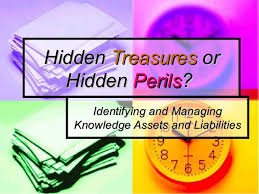Dear all...
I was invigilating masters student in information management yesterday. Though I did not teach them, I am pretty much close to the subject they were taking.......years back, I happened to be involved in the development of one of the subject, Knowledge Management. Yesterday the final examination subject is on Epistemology of Information Management. I looked through the questionnaire and have the chance of browsing through the whole set of questions. One of the question asked about the identification of the knowledge assets in the knowledge management (KM) implementation.
I was intrigued by the question in the question paper while invigilating the students, my mind kept working......
Here is some input that I want to share with my blog readers....
 Tapping the knowledge which comprises of skills, experiences, methods and approaches, lesson learnt, mistakes and others requires information professionals to look at two distinct categories of source of knowledge in the form of tacit and explicit knowledge. The so called tacit knowledge can only be useful when it is converted to explicit knowledge and later readily available, can be derived and referred to by others. It is where the explicit knowledge may contains past decision makings or actions taken or reported development of a project or initiatives made by a team, organization or a department through different phases of development.
Tapping the knowledge which comprises of skills, experiences, methods and approaches, lesson learnt, mistakes and others requires information professionals to look at two distinct categories of source of knowledge in the form of tacit and explicit knowledge. The so called tacit knowledge can only be useful when it is converted to explicit knowledge and later readily available, can be derived and referred to by others. It is where the explicit knowledge may contains past decision makings or actions taken or reported development of a project or initiatives made by a team, organization or a department through different phases of development.
Tacit knowledge can be very much meaningful when it is transformed or converted and put into proper documentation, and recorded in any possible form. Through textual documentation, the tacit knowledge can now be referred to, lesson learnt can be derived as well by users, people or other team members working on a particular project or program.
 The converted tacit knowledge is now residing in organizational database or knowledge portal or maybe recorded and kept in a file. It exists everywhere, referred to anytime by anybody necessarily.
The converted tacit knowledge is now residing in organizational database or knowledge portal or maybe recorded and kept in a file. It exists everywhere, referred to anytime by anybody necessarily.
These are records or an organization or a corporate memory of an institution.
Ironically, without records, tacit knowledge will be gone. It is literally not documented and resided in the mind of the people. Though useful, it is not meaningful.
The development of knowledge management depended heavily on the practices of information management which in particular the management of records in an organization. Institution embarking on knowledge management initiatives must look at the vast potential of records management as the source of explicit knowledge of an organization - corporate memory.
What happen if tacit knowledge is not captured? Not converted into recorded information? Not documented properly and kept in a central repository? Initially, organization will lose its huge potential of years of experience and high cost of investment in training cost, staffs involvement in critical projects, success stories, lesson learnt and past mistakes which can be avoidable if project teams took a lesson learnt from it.
 Effective records keeping or records management will help organization to leverage and capitalize on its own internal knowledge. Past actions would help decision/policy makers to make decision more effectively and efficiently. Mistakes and high risk of monetary or non monetary may be avoidable if project teams learn from the past actions derived from reports, previous project undertakings, decisions made.
Effective records keeping or records management will help organization to leverage and capitalize on its own internal knowledge. Past actions would help decision/policy makers to make decision more effectively and efficiently. Mistakes and high risk of monetary or non monetary may be avoidable if project teams learn from the past actions derived from reports, previous project undertakings, decisions made.
Success stories could also be captured, shared and routed electronically when the stories are captured in whatever ways possible. New staffs or existing staffs could learn from the success stories which may inspire them to achieve organizational targets and objectives. Organization may also repeat the success or crafting better success or achieving higher objectives and targets. The lesson learnt from the failure or mistakes made in the course of initiating projects previously will secure organization from repeating the same mistake. This ensures higher success rates alternately reducing project losses financially.
 Least to say, without records management which we can tap into knowledge assets, knowledge management would not working. KM success is highly dependable on the effective and efficient record keeping in organization. It is where the knowledge assets are derived from. Having proper documentation, recorded transactions, decisions makings, evidence of past actions and later classify it properly in a manner that it is easily retrievable and searchable using proper taxonomy will make knowledge assets more meaningful to organizations. (Please refer to SECI Model by Nonaka)
Least to say, without records management which we can tap into knowledge assets, knowledge management would not working. KM success is highly dependable on the effective and efficient record keeping in organization. It is where the knowledge assets are derived from. Having proper documentation, recorded transactions, decisions makings, evidence of past actions and later classify it properly in a manner that it is easily retrievable and searchable using proper taxonomy will make knowledge assets more meaningful to organizations. (Please refer to SECI Model by Nonaka)
I was invigilating masters student in information management yesterday. Though I did not teach them, I am pretty much close to the subject they were taking.......years back, I happened to be involved in the development of one of the subject, Knowledge Management. Yesterday the final examination subject is on Epistemology of Information Management. I looked through the questionnaire and have the chance of browsing through the whole set of questions. One of the question asked about the identification of the knowledge assets in the knowledge management (KM) implementation.
I was intrigued by the question in the question paper while invigilating the students, my mind kept working......
Here is some input that I want to share with my blog readers....
Tacit knowledge can be very much meaningful when it is transformed or converted and put into proper documentation, and recorded in any possible form. Through textual documentation, the tacit knowledge can now be referred to, lesson learnt can be derived as well by users, people or other team members working on a particular project or program.
 The converted tacit knowledge is now residing in organizational database or knowledge portal or maybe recorded and kept in a file. It exists everywhere, referred to anytime by anybody necessarily.
The converted tacit knowledge is now residing in organizational database or knowledge portal or maybe recorded and kept in a file. It exists everywhere, referred to anytime by anybody necessarily.These are records or an organization or a corporate memory of an institution.
Ironically, without records, tacit knowledge will be gone. It is literally not documented and resided in the mind of the people. Though useful, it is not meaningful.
The development of knowledge management depended heavily on the practices of information management which in particular the management of records in an organization. Institution embarking on knowledge management initiatives must look at the vast potential of records management as the source of explicit knowledge of an organization - corporate memory.
What happen if tacit knowledge is not captured? Not converted into recorded information? Not documented properly and kept in a central repository? Initially, organization will lose its huge potential of years of experience and high cost of investment in training cost, staffs involvement in critical projects, success stories, lesson learnt and past mistakes which can be avoidable if project teams took a lesson learnt from it.
Success stories could also be captured, shared and routed electronically when the stories are captured in whatever ways possible. New staffs or existing staffs could learn from the success stories which may inspire them to achieve organizational targets and objectives. Organization may also repeat the success or crafting better success or achieving higher objectives and targets. The lesson learnt from the failure or mistakes made in the course of initiating projects previously will secure organization from repeating the same mistake. This ensures higher success rates alternately reducing project losses financially.

No comments:
Post a Comment